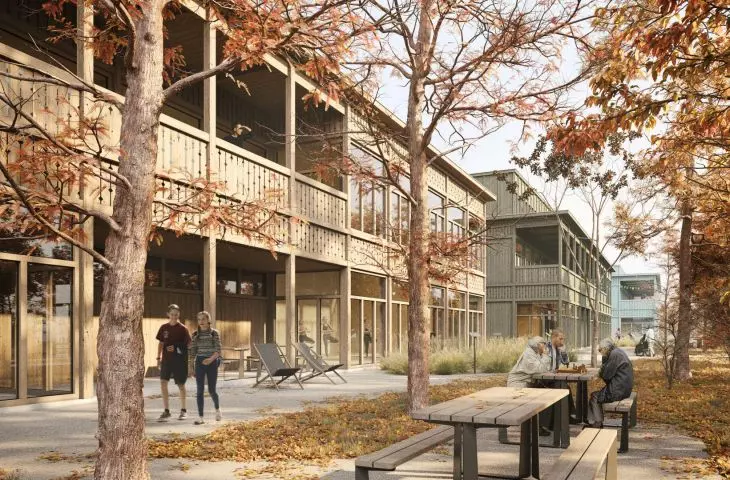A center for Intergenerational Activity Center will be built in Warsaw's Wawer district. Surrounded by a forest, the complex will be built to allow for rest, recreation, and social gatherings.
In a competition organized by the Bureau of Architecture and Spatial Planning of the City of Warsaw and the Wawer District Office, the winner was BDR Architects. The Center for Intergenerational Activities is a complex of three buildings comprising the eponymous CAM institution, a support center and a nursery. For the architects, the most important thing was to create an open space, providing contact with nature, as well as referring to the local architecture - the "Świdermajer" style.
location
Each object will be in a different color to facilitate orientation in the area. The subdued color scheme is primarily intended to adapt to the surroundings and create the impression of being in an intimate rest home.
CAM Wawer visualization
© BDR Architekci
The asset of the plot is the natural forest greenery. This creates the impression of a space free from the hustle and bustle of the city and conducive to outdoor activities. To offset the impact of traffic noise, the architects placed the technical and sanitary rooms on the street side. The most important rooms have been located so that they overlook green areas, where water lenses have been used to allow water retention. All buildings have a simple layout of corridors. Outside, they were connected by glass winter gardens.
It was important for the designers to refer to the local architectural tradition - the "Swidermajer" style. The facades of the buildings will be finished with planks of treated softwood. Balustrades and strips between floors are enriched with carpentry details, referring to traditional villas in the region.
Paweł Dadok, one of the project's creators, talks about the project
Wiktor Bochenek: Theinfluence of the surroundings - local architecture and forest areas - is evident in the project. How did you try to integrate the block into this environment?
Pawel Dadok: The plot currently has a forest character, and in the design we tried not to lose this and use it in the project, preserving as many trees and lower plants as possible.
The building is intended to be an intergenerational center, a place that is friendly, recognizable to the community and one that residents will want to "befriend".
The form and, in a sense, the structure of CAM draw on the Swidermayer style, characteristic of early 20th century resort architecture in the area.
This reference, conscious and clear at first glance, has met with acceptance and a positive response from the residents of Warsaw's Wawer district and the city.
So we hope that the completed building will blend in all the more with the environment, understood broadly as: natural, social and cultural.
CAM Wawer visualization from a bird's eye view
© BDR Architects
Wiktor Bochenek: What does the dialogue with "Swidermajer" consist of? How have you tried to use it in modern architecture.
Pawel Dadok: It is based on noticing and using in the design the characteristic elements of this architecture, such as the light open character, the restful terraces and porches, the treatment of wood in the construction and detailing. In our opinion, the CAM project is not modern architecture and was not meant to be either. It is contemporary architecture, which in the case of this function and location for us means that it should be rooted in locality, which in is exceptionally successful wooden architecture of the turn of the 20th century.
One of the glazed lobbies in the complex
© BDR Architects
Wiktor Bochenek: How does the building allow you to combine different functions? Can it be used by everyone?
Pawel Dadok: The complex is divided into 3 independent facilities, a nursery, a senior citizen activity center and a support center. According to the competition, it was necessary to solve these functions in such a way that they were, on the one hand, independent and, on the other hand, conducive to integration in an unforced manner.
The space for integration in the project is the natural reclaimed forest vegetation preserved in the western part of the plot and the glazed gardens between the buildings. In the design, we wanted the glazed gardens to be accessible to everyone, from them one only enters the entrance halls located in the blocks of the buildings, from them one can finally access public rooms such as the gymnasium, the kiosk, the office. We assume that everyone will be able to use them, of course, during the designated hours.
visualization of the terraces
© BDR Architects
Wiktor Bochenek: What was the most difficult part, and what are you most proud of?
Paweł Dadok: The most difficult thing was to arrange the buildings on the plot in such a way as to provide the quiet green space so necessary for rest, study and play. Along the eastern side of the plot runs a fairly busy road and railroad tracks. We are pleased with the character and mood that the project has managed to create. We would not have succeeded without the wonderful examples of architecture of the "Swidermajer" style, from which we drew in full handfuls.


































